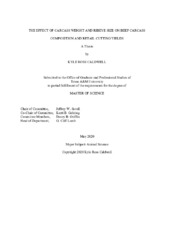| dc.description.abstract | According to the NBQA, average HCW and REA of beef carcasses have increased from the first audit in 1995 to the most recent in 2016 by 51.9 kg and 7.6 cm2 , respectively. These factors have been correlated to the relative size of other muscles in the body, which effect the overall cut size consistency for foodservice professionals, retailers and consumers alike. The objectives of this study were to collect weights, dimensional measurements, and retail yield data from specified muscles and subprimals to determine the impact of varying HCW and REA sizes on carcass composition. Beef carcasses (n = 36) were selected to fill a 3 X 3 treatment structure of HCW categories of 340.6 to 385.6 kg, 386.0 to 430.9 kg and 431.4 to 476.3 kg as well as REA categories of 83.9 to 89.8 cm2 , 90.3 to 96.1 cm2 and 96.7 to 102.6 cm2 with four carcasses in each of the nine treatment groups. One hindquarter from each carcass (n = 18) was randomly selected to undergo a dissection while the remaining side (n = 18) was subjected to conventional fabrication at a collaborating beef packer. Dissected muscles and subprimals were cut into retail steaks at a commercial case-ready facility to be cut into retail to derive a true percentage of boneless, closely trimmed retail cuts. Muscles grow largely in concert to one another, with statistical differences in dimensional properties, especially muscle weight occurring between carcasses in the lightest HCW category and the heaviest HCW category. HCW accounted for a greater number of significant differences than did REA, suggesting that HCW could be a more accurate predictor of muscle size. Retail yield from this study showed differences in the number of steaks produced between weight categories with the lightest HCW category producing fewer steaks and roasts than heavier HCW categories. Compositional data were also analyzed to determine the percentage changes in muscle weight as REA and HCW increased. HCW produced the greatest effect on the M. longissimus lumborum as the muscles from the lightest weight category made up 1.9% more of their respective hindquarter weights than those muscles in the 386.0 to 430.9 kg category and 0.8% more than the heaviest HCW category. These findings will prove useful in developing new marketing strategies and predictive methods to satisfy foodservice and retailers demanding a more consistent subprimal size. | en |


